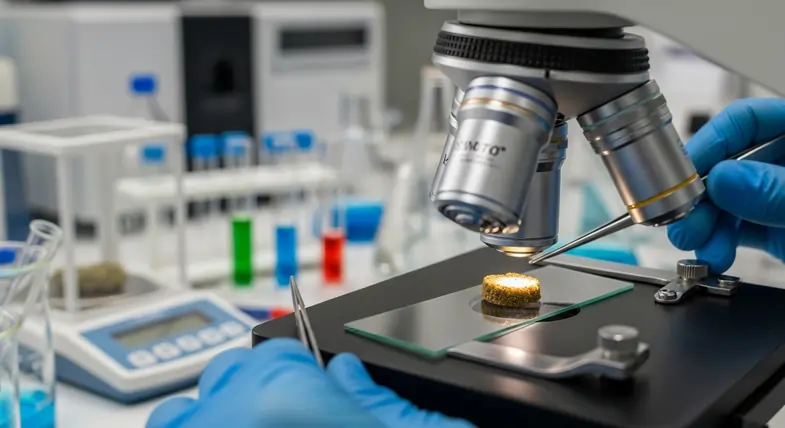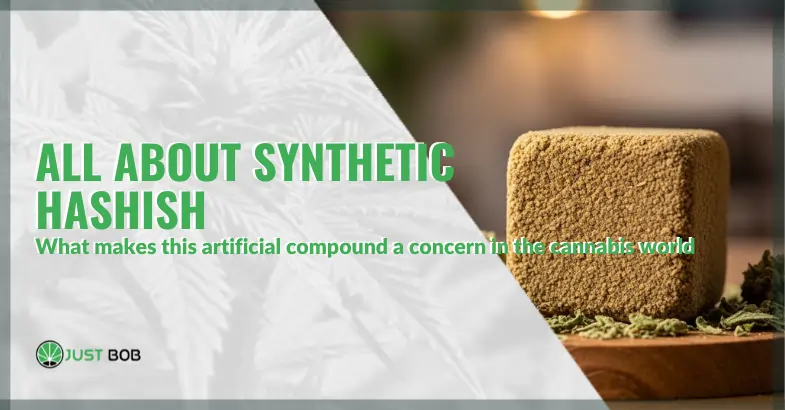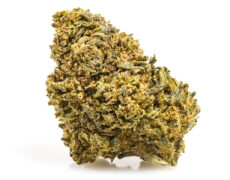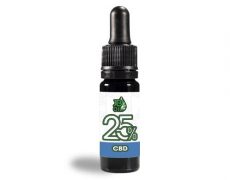Modified on: 26/10/2025
Behind catchy names and colorful packaging lies an unstable and toxic drug, often used to adulterate even traditional cannabis.
While legal cannabis is gaining ground in public debate and on the market, a lesser-known but far more alarming phenomenon is spreading in the shadows: synthetic cannabinoids. Marketed as ‘synthetic hashish’ or harmless herbal blends, these products are anything but harmless.
They are substances created in laboratories to mimic the effects of THC, the active ingredient in cannabis, but with a potency and danger that have nothing to do with natural derivatives.
Their chemical structure, often modified to circumvent regulations, interacts with the body in unpredictable ways. The health risks are real and documented: psychotic episodes, serious neurological disorders, cardiovascular damage, and even potentially fatal consequences.
Yet these compounds continue to circulate, often sold online or on illegal markets, disguised as incense, room fragrances, or other seemingly legitimate products.
This article aims to provide clear, reliable, and prevention-oriented information. It is essential to remember that any substance capable of altering the mental state, even if presented as “natural” or “legal,” can pose serious health risks.
Read also: How marijuana is grown in winter: challenges, techniques and environmental factors
Understanding the basics: natural vs. synthetic cannabinoids
To fully grasp the seriousness of the risk associated with synthetic compounds, it is essential to start with a fundamental distinction. The hemp plant naturally produces over a hundred chemical compounds known as phytocannabinoids. These play a vital role for the plant itself, protecting it from pests and environmental stress.
When ingested by humans, these compounds interact with our endocannabinoid system (ECS), a complex network of cell receptors that regulates crucial physiological functions such as mood, sleep, appetite, and pain perception. The two most studied phytocannabinoids are:
- Tetrahydrocannabinol (THC): the main psychoactive component of cannabis, responsible for the ‘high’ sensation. It acts by binding primarily to CB1 receptors in the brain, temporarily altering sensory perception and cognitive function.
- Cannabidiol (CBD): a non-psychoactive cannabinoid, valued for its potential soothing, anxiolytic, and anti-inflammatory properties. Unlike THC, CBD does not cause intoxicating effects and modulates the endocannabinoid system in a more subtle and indirect way.
Legal hashish products are strictly controlled to ensure that THC levels are within the limits set by law, thus offering the potential benefits of CBD and other non-psychoactive cannabinoids without the psychotropic effects associated with illegal cannabis.
What happens, however, when artificial, man-made molecules interact with our endocannabinoid system? This is where the picture changes dramatically, opening the door to unknown and dangerous territory.


What exactly are synthetic cannabinoids?
Synthetic cannabinoids, technically known as cannabinoid receptor agonists, are chemicals created in clandestine laboratories. Despite their name, their chemical structure is often very different from that of THC. Their only commonality is their ability to bind to the same CB1 and CB2 receptors in our brain. However, they do so with much greater potency and effectiveness (or “affinity”), sometimes up to 100 times greater than that of natural THC.
This hyper-potent interaction is the root of their unpredictability and danger. While natural THC acts as a partial agonist, synthetic cannabinoids are often full agonists. This means that they activate cannabinoid receptors to their maximum capacity, triggering an overwhelming and potentially toxic physiological and psychological response.
These compounds are typically synthesized in liquid or solid form and then sprayed onto dried plant material (which can be any inert herb, not necessarily hemp) to be sold as “synthetic marijuana.” They are marketed under catchy and ever-changing names to evade authorities, such as:
- Spice
- K2
- Black Mamba
- Blaze
- Nitro
- Skunk (not to be confused with the natural cannabis variety).


The effects: an unpredictable cascade of health risks
While the effects of natural cannabis have been studied for decades, those of synthetic cannabinoids remain largely unknown, with new molecules constantly appearing on the market.
However, numerous studies and research confirm their harmfulness to the body, especially in adolescents.
The effects reported by healthcare professionals and users themselves are alarming and can be divided into three main categories.
1. Psychiatric effects
Taking these substances can cause very serious psychological consequences, far removed from the feeling of relaxation or euphoria sometimes associated with cannabis. In many cases, the effects are acute and destabilizing: episodes of extreme paranoia accompanied by intense and persistent anxiety can occur, making it difficult to distinguish reality from altered perception.
It is not uncommon to observe a state of increasing agitation, with aggressive behavior and mental confusion so severe that it compromises the ability to orient oneself. Added to this are particularly disturbing visual and auditory hallucinations, often experienced as truly terrifying experiences. In some individuals, these manifestations evolve into psychotic episodes which, if not treated adequately and in time, can leave permanent psychiatric damage.
2. Cardiovascular effects
The cardiovascular system is one of the most vulnerable to these substances. The intense activation of CB1 receptors can trigger a series of dangerous reactions, especially in the circulatory system. Blood pressure tends to rise significantly, reaching life-threatening levels, especially when associated with marked tachycardia, with rapid and often irregular heartbeats.
This state of hyperactivation may be accompanied by uncomfortable palpitations and a sense of chest tightness, which in some cases manifests as actual chest pain. In severe cases, which have unfortunately also been documented in young and healthy individuals, these changes can lead to acute events such as myocardial infarction.
3. Neurological and systemic effects:
The impact of these substances is not limited to the brain or heart: the entire body can be overwhelmed by a toxic reaction involving various systems. At the neurological level, sudden convulsions may occur, accompanied by violent and uncontrollable tremors, indicating a profound alteration in brain electrical activity.
The digestive system is not spared, with intense nausea and persistent vomiting further debilitating those who have taken the substance. Added to this is profuse sweating and a dangerous rise in body temperature, known as hyperthermia, which can quickly put vital functions at risk.
In the most severe cases, a process called rhabdomyolysis, or the destruction of muscle tissue, can occur: the massive release of proteins into the blood can seriously damage the kidneys, leading to acute renal failure, which in some patients requires urgent intervention such as dialysis.
It is essential to emphasize a crucial point: the use of synthetic cannabinoids can be fatal. Unlike natural cannabis, for which there has never been a documented case of death from overdose, synthetic compounds have caused numerous deaths worldwide.
Furthermore, these mixtures are often ‘cut’ with other unknown chemicals, including poisons or industrial additives, to increase their volume or effect, introducing an additional, terrifying level of risk.
Read also: 7 natural remedies for sleep that don’t involve pharmaceuticals
A game of cat and mouse: why are these products still in circulation?
One might legitimately ask how such dangerous substances are still so easily available today. The explanation lies in a continuous and exhausting mechanism, similar to a chase between those who produce them and those who try to stop them. It is a real game of cat and mouse between clandestine laboratories and regulatory authorities.
Every time a new synthetic molecule is identified and added to the list of controlled substances, illegal producers react almost immediately. A minimal change to the chemical structure is enough to obtain a technically new compound, not yet classified as illegal, but capable of producing similar or even more intense effects than the original. This continuous molecular updating allows them to stay one step ahead of the law.
Making the situation even more complicated is the misleading labeling with which these substances are often marketed.
On an operational level, there is also a real problem of identification: common drug tests, such as those on urine or saliva, are not designed to detect constantly evolving synthetic compounds. Identifying them requires advanced forensic analysis, which is more complex and expensive and cannot be applied on a large scale in routine checks.
To combat this phenomenon, some countries have introduced broader regulations. This is the case of the Psychoactive Substances Act of 2016 in the United Kingdom, which bans any substance capable of altering the mental state, regardless of its chemical structure.
But despite these attempts, the production and spread of these drugs has not stopped. Today, they continue to circulate through unregulated channels, often online or through networks that are difficult to monitor, making the fight against their spread even more complex.
The adulteration alert: a hidden risk
One of the most alarming trends reported by harm reduction organizations in different parts of Europe is the adulteration of low-THC cannabis with synthetic cannabinoids.
The mechanism is sneaky: dishonest producers buy cheap legal hemp, spray it with a solution of synthetic cannabinoids, and resell it on the black market as high-potency cannabis.
These adulterated products are visually indistinguishable from normal cannabis. Only laboratory analysis can reveal their true nature. Those who have brought such samples for analysis to harm reduction projects have often reported abnormal effects: severe headaches, intense nausea, an unpleasant “chemical” effect, and a general feeling of malaise, far removed from the known effects of cannabinoids.
This phenomenon dramatically highlights the importance of sourcing products exclusively from reliable and legal sources, obviously only in countries where the consumption of legal hash is permitted by law. Purchasing products from unverified channels or the black market is not only illegal, but also exposes you to an incalculable risk to your health.
Choosing safety and awareness
The rise of synthetic hashish and artificial cannabinoids poses a serious threat to the world of legal cannabis. These are not “stronger versions” of marijuana, but different, unpredictable, and dangerous chemicals whose only similarity to cannabis is their name.
The effects can range from severe psychological crises to permanent physical damage and even death. Their ever-changing chemical nature and misleading marketing make them an invisible but real danger.
The way forward is clear and unambiguous: legality, transparency, and safety.
Relying on products such as legal cannabis or CBD oil from certified and reliable sellers ensures that what you buy has been tested, checked, and complies with current regulations.
The products offered by Just Bob are designed for specific purposes such as collecting, aromatherapy, or technical use, in a context of full transparency and legality.
Acting with awareness also means being properly informed and, when necessary, consulting a health professional for individual assessments. Knowledge remains the most effective tool for protecting yourself and making responsible choices.
Synthetic hashish: takeaways
- Synthetic cannabinoids (“Spice,” “K2”) are laboratory chemicals, not natural derivatives of the hemp plant. Their structure and effects are radically different and much more dangerous than natural THC.
- The use of these compounds can cause serious health consequences, including psychosis, heart attacks, kidney failure, and death. Unlike natural cannabis, overdose is a real and documented risk.
- Due to the risk of adulteration, it is crucial to purchase cannabis products exclusively from legal and reputable suppliers. This is the only way to be sure of the product’s composition and avoid the dangers of hidden synthetic compounds.
Synthetic hashish: FAQ
What’s the difference between synthetic cannabinoids and natural THC?
Synthetic cannabinoids are man-made chemicals designed to mimic the effects of THC, but they are fundamentally different in structure and effect. Unlike natural THC, which is a partial agonist of cannabinoid receptors, synthetic versions often act as full agonists—meaning they overstimulate the brain’s receptors, leading to unpredictable and potentially dangerous reactions. In short: the similarities stop at the name.
Can synthetic cannabinoids really be found in cannabis sold on the street?
Yes, and that’s one of the most alarming trends. Some black market sellers spray legal hemp with synthetic cannabinoids and pass it off as high-potency cannabis. Visually, it’s nearly impossible to detect the difference. Only laboratory testing can confirm adulteration, which makes buying from unverified sources extremely risky.
Are synthetic cannabinoids legal?
Not really. While producers often modify the chemical structure slightly to stay ahead of the law, many countries—including the UK with the Psychoactive Substances Act 2016—have introduced broad bans on any substance that can alter mental functioning. Even when not explicitly listed, these compounds are often caught under such general legislation. Buying or possessing them is not only illegal in many jurisdictions but also extremely unsafe.









